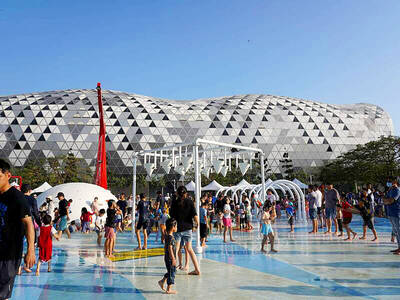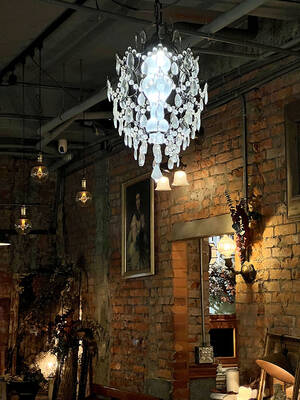Hsieh Li-hsiang (
Almost two years in preparation, the restaurant opened for business three weeks ago.
The exterior, an abstract sculpture of two Tao aborigines performing a frenetic hair dance commands attention of all who pass it; this encloses a massive four-story space that can seat up to 850 diners in comfort, along with a huge collection of iron, driftwood and clay sculptures, and a host of rough stone antiques imported from China.

PHOTO: IAN BARTHOLOMEW, TAIPEI TIMES
Hsieh sees herself primarily as an artist, and insists that the chain of restaurants she now runs, extending across the island, is an excuse to showcase her buildings and art. Fortunately, she has been lucky with her chefs, for the food, which is billed as innovative Taiwanese, is of sufficient quality and generously portioned to keep the punters coming back for more.
The banquet menu at NT$800 for 10 courses is an absolute bargain for big eaters. It is the kind of food you might expect to get at a traditional Taiwanese-style street-side banquet, though as everything is served on rustic crockery that has been designed by Hsieh and is made specifically for her restaurants, the effect is rather more sophisticated.
Display and atmosphere are an important part of the dining experience here, and for those looking to get their first taste of Taiwanese cuisine and social mores, Wu Chiao Chuan Ban is an excellent choice. While the quality of the food is not uniform, and some of the innovations may grate on the sensibilities of purists, the restaurant has established a strong reputation with locals through its outlets in southern Taiwan. Some dishes, such as the rice paste served for desert -- a variation on traditional mochi -- are wildly popular.
The food is certainly prepared with an eye for color and design, and the flavors are definitely robust -- very much in keeping with the rough and restless interior design.
In addition to the regular banquet menu (which requires at least four people), there is also a six-course vegetarian banquet, numerous seasonal specialties and a range of individual dishes that are offered for between NT$300 to NT$500, including a drink and desert.
Whatever else it may be, Wu Chiao Chuan Ban is likely to establish itself in Taipei as firmly as it has elsewhere on the island, and add to the variety of the culinary experience of Taipei's diners.

The Taipei Times last week reported that the rising share of seniors in the population is reshaping the nation’s housing markets. According to data from the Ministry of the Interior, about 850,000 residences were occupied by elderly people in the first quarter, including 655,000 that housed only one resident. H&B Realty chief researcher Jessica Hsu (徐佳馨), quoted in the article, said that there is rising demand for elderly-friendly housing, including units with elevators, barrier-free layouts and proximity to healthcare services. Hsu and others cited in the article highlighted the changing family residential dynamics, as children no longer live with parents,

The classic warmth of a good old-fashioned izakaya beckons you in, all cozy nooks and dark wood finishes, as tables order a third round and waiters sling tapas-sized bites and assorted — sometimes unidentifiable — skewered meats. But there’s a romantic hush about this Ximending (西門町) hotspot, with cocktails savored, plating elegant and never rushed and daters and diners lit by candlelight and chandelier. Each chair is mismatched and the assorted tables appear to be the fanciest picks from a nearby flea market. A naked sewing mannequin stands in a dimly lit corner, adorned with antique mirrors and draped foliage

The election of Cheng Li-wun (鄭麗文) as chair of the Chinese Nationalist Party (KMT) marked a triumphant return of pride in the “Chinese” in the party name. Cheng wants Taiwanese to be proud to call themselves Chinese again. The unambiguous winner was a return to the KMT ideology that formed in the early 2000s under then chairman Lien Chan (連戰) and president Ma Ying-jeou (馬英九) put into practice as far as he could, until ultimately thwarted by hundreds of thousands of protestors thronging the streets in what became known as the Sunflower movement in 2014. Cheng is an unambiguous Chinese ethnonationalist,

I was 10 when I read an article in the local paper about the Air Guitar World Championships, which take place every year in my home town of Oulu, Finland. My parents had helped out at the very first contest back in 1996 — my mum gave out fliers, my dad sorted the music. Since then, national championships have been held all across the world, with the winners assembling in Oulu every summer. At the time, I asked my parents if I could compete. At first they were hesitant; the event was in a bar, and there would be a lot